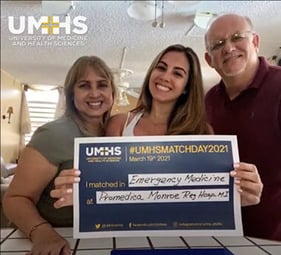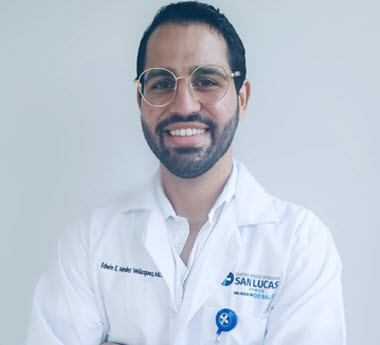 If you are looking for the most accurate and up to date information about the Medical specialty of Emergency medicine and how to become an ER doctor, then you are in the right place.
If you are looking for the most accurate and up to date information about the Medical specialty of Emergency medicine and how to become an ER doctor, then you are in the right place.
As a Medical school, we have created this article for prospective Medical students and others wanting to know about the path to becoming an Emergency medicine specialist. Click this quick link to go to that part of this article now. In addition, we answer the 11 most frequently asked questions that our Admissions specialists receive about this profession.
We feel it is imperative that every person reading this article grasps the concept of the dedication and years of training needed to complete an Emergency medicine residency, obtain licensure and work as an Emergency Med Specialist in the United States or Canada.
Also please check out these alumni interviews with three Emergency med specialists.
 At-a-glance
At-a-glance
Free guide
Emergency Medicine: Is it the right specialty for you?
- Scope of Practice
- Future Job Outlook
- Salary & Work Statistics
Quick access. No spam. 10 pages.
Navigation Links to 11 FAQ's about Emergency Medicine and ER Doctors
- What are the sub-specialties available for Emergency Doctors?
- What exactly is an Emergency room Doctor?
- What do ER Physicians do?
- Where do ER specialists work?
- How many years of training do ER Doctors complete to become licensed?
- What major should I have in College to become an ER physician?
- Is a career in ER medicine worth it?
- What is the average salary for Emergency medicine specialists?
- How much does it cost to become an Emergency medicine specialist??
- Do ER Doctors do Surgery?
- How to pursue a career in Emergency medicine?
Emergency Medicine Physician Training - How to become an ER Doctor?
The amount of education and training to become a licensed ER Doctor is very rigorous and lengthy. Assuming that a high school diploma has been obtained, the six major education and training steps to becoming an ER Doctor are the following:
Step 1: Enroll in an undergraduate college and take the courses required for Medical school admission.
While some Medical schools require slightly different prerequisite courses, most require the following courses to be completed:
- Inorganic and organic chemistry with a lab
- Mathematics
- Biology
- English composition - writing skills
Medical school admissions counselors suggest that in order to be competitive, applicants should strive to get a letter grade of B or better in their coursework. They also point out that while Biochemistry is not a course that is one of the requirements for application into many Schools of Medicine, it is a subject that is tested on the medical college admissions test (MCAT) discussed in the next section. Many also believe that completing a class is physiology is helpful. Most matriculants complete a bachelor's degree program such as a Bachelor's of science (BS) or Bachelor's of arts (BA), although it is not a requirement for admission. Leadership positions, research projects, volunteering, and shadowing of Doctors in clinical practices should be ongoing activities for all med school hopefuls during this phase of an applicant's life.
Step 2: Make preparations for and complete the (MCAT) Medical College Admission Test.
A high MCAT score is required to be highly considered for medical school. Many Medical schools use computer based algorithms to screen candidates. If a prospective Medical student has scores below the a set level, applicants are rejected immediately. The MCAT is a computer-based, seven and a half hour examination, where there are four areas of knowledge that are tested. According to the American Association of Medical Colleges (AAMC) these include:
- Chem/Phys - Chemical and Physical Foundations of Biological Systems
- CARS - Critical Analysis and Reasoning Skills
- Bio/Biochem - Biological and Biochemical Foundations of Living Systems
- Psych/Soc - Psychology, Social, and Biological Foundations of Behavior
For more information about the MCAT, please check out this website.
Step 3: Apply, get accepted, attend and complete an accredited Osteopathic or Allopathic Medical school.
Medical school can be broken down into two distinct parts, the pre-clinical foundations of medicine and the clinical medicine portion. The first two years of Med school are spent mostly in the classroom where medical education is didactic in nature. Coursework includes:
- Basic medical knowledge foundation courses
- Anatomy of the human body and dissection lab
- Physiology
- Illnesses & Pathology
- Pharmacology
- Diagnostics and treatments and other basic concepts of Medicine
Students also learn basic medical skills and reasoning applicable to all medical professions including taking patient histories and other skills such as the diagnosis of diseases and body functions and structure.
Towards the end of the second year of school, students prepare to take what many say is the most difficult test in the career cycle of Medicine, the United States Medical Licensing Examination Step 1 (USMLE Step 1) for students in MD programs or the COMLEX-USA Level 1 for DO programs.
Year three and four of Medical school is dedicated to Clinical medicine where students get hands-on experience with patients at teaching hospitals, learning clinical skills. Third year is spent in mandatory rotations, also known as a Clinical clerkships. Most Medical schools require the following clerkships but this may vary slightly:
- Internal medicine
- Pediatrics
- Family medicine
- Psychiatry
- OB-GYN (obstetrics and gynecology)
- Neurology
- Surgery
In the fourth year, students can choose clinical rotations in a specific area of medicine that they would like to focus on. These are called audition rotations, more formally known as Sub-internships. This may be the first time that students wanting to become emergency doctors get exposure to patient care inside the emergency room and find out exactly what ER Doctors do. Students that are unsure of the Medical specialty they would like to practice in, may elect to have audition rotations in several different specialty areas at different residency programs nationwide. At the same time, residency programs assess Medical students to determine their future suitability as residents.
Most Medical students take the Step 2 or Level 2 examinations of the USMLE or COMLEX-USA during the end of their third or beginning of fourth year. Residency programs require Step 1 and Step 2 board examinations to be completed and passed before residency can begin. Upon graduation, students are now considered "Doctors" as they have earned either the doctor of medicine degree (MD) or the doctor of Osteopathy (DO) medical degree and are eligible to obtain a limited medical license.
Step 4: Complete Internship (or Intern year) and Emergency medicine Residency.
Residency in Emergency medicine is a three to five year program with four years being the norm. Graduate Medical students in an Emergency medicine residency program can now officially be called Doctors, however, they are not allowed to practice without supervision. The first year of Emergency medicine residency is called an Intern year. It is during this time that residents work in a very stressful environment, such as in hospitals in the emergency room, also know as Emergency department (ED) and learn actual emergency medical care. This is also when the final National board examination, The COMLEX Step 3 or USMLE Step 3 is completed. Intern years and residency positions are paid programs and vary in the salaries by State and Institution.
Step 5: Specialty Board Certification.
Although not required for professional license, board certification in Emergency medicine is a highly desirable credential that displays expertise, knowledge, and competence Almost all employers, however, demand certification. The American Board of Emergency Medicine is the credentialing board for Allopathic (Doctor of Medicine) MDs and The American Osteopathic Board of Emergency Medicine is the credentialing body for Osteopathy trained doctors (D.O.).
Step 6: Complete subspecialty training (Fellowship). Optional
Following completion of an emergency medicine residency, individuals are now a fully trained emergency doctor and can now choose to, or not to pursue advanced training in one of the subspecialties of emergency medicine. However, this is not required to find excellent work opportunities and a rewarding career. Please continue reading about Fellowships and subspecialties in the section below.

What are the Fellowships and subspecialties an emergency medicine physician can pursue?
There are many optional fellowship programs that Emergency Med Doctors can choose to study after completion of medical residency. These subspecialties include:
- Medical Toxicology - 2 years in length or more
- Pain Medicine - 1 to 2 years in length
- Internal Medicine / Critical Care Medicine - 2 years in length
- Hospital and Palliative care - 1 year in length
- Neurocritical Care - 2 years in length
- Pediatric Emergency Medicine - 2 to 3 years in length
- Sports Medicine - 1 year in length or more
- Anesthesiology Critical Care - 1 to 2 years in length
- Emergency Medical Services - 1 year in length
- Undersea and Hyperbaric Medicine - 1 year in length
What is an ER doctor?
An ER Doctor is a residency trained and licensed physician with M.D. or D.O. degrees that is trained in Emergency Medicine (EM). They take care of emergent or acutely sick patients upon their first presentation to the hospital. The primary role of the Emergency medicine doctor is to first stabilize the patient, then come up with a differential diagnosis for the medical ailment, and lastly, refer the patient to the correct medical service (such as cardiology or general surgery) or discharge the patient home with appropriate treatment. Throughout this process, Emergency medicine doctors will perform physical exams, order and interpret laboratory tests and imaging, perform diagnostic procedures, provide treatment, and much more. This requires emergency medicine practitioners to have a wide knowledge of diseases that affect children and adults of all ages.
What does a Emergency medicine doctor do?
ER Doctors are highly trained physicians that have the ability to see more than one patient at the same time. They specialize in treating and stabilizing patients with acute conditions so that they can be admitted to the hospital and be seen by other specialized physicians such as cardiologists, neurologists, and surgeons. They primarily work in the Emergency department (ED) and assess, triage, and treat patients based upon the severity of the medical problem. They treat patients with life threatening issues or the most severe problems first.
The top five most common conditions that Emergency Medicine Physician encounter are:
- Acute trauma, injury, or fracture
- Angina, chest pain, heart attack and coronary disease
- Infectious diseases
- Abdominal pain
- Musculoskeletal pain
To do their job, they perform physical exams and perform Medical procedures such as:
- Intubation
- Suturing
- Joint relocation
- Access arteries and veins
Additionally, they order and interpret laboratory tests and imaging including:
- Urinalysis
- X rays
- MRI and CT scans
- Arterial blood gas
- Toxicology screens
- Complete metabolic panels
Where do Emergency Medicine specialists work?
ER doctors mainly work in a hospital emergency department (ED). They may also work in urgent care centers, intensive care facilities, and may even perform emergency medical services in a pre-hospital setting. As their job is to stabilize patients with acute injuries, Emergency specialist doctors must be able to quickly evaluate medical situations and refer their patients to other doctors in medical departments such as neurosurgery, infectious diseases, and cardiology.
How long does it take to become an ER doctor?
It takes at least eleven years after high school to become an ER doctor. This includes four years of undergraduate studies, four years of medical school, and three to five years of residency depending upon the teaching hospitals where the residency programs are attended.

What major should I have to get into Medical school and eventually practice as Emergency Room Physician?
There is not a specific major required to apply to medical school and eventually practice emergency medicine. Obtaining a bachelors degree is not required but still is very common. Instead, medical schools have a list of required courses. These courses commonly include quite a few biology and chemistry courses as well as physics, math, and literature courses. As biology and chemistry make up the majority of required courses many medical school applicants tend to have undergraduate degrees with majors in these two areas.
Is becoming an ER Doc worth it?
According to the American College of Emergency Physicians, the number of patients requiring services in the emergency department has grown by 32 percent in the past twenty years. However, during this same time period the number of hospital emergency departments has decreased by 7 percent. This has led to an increasing need of emergency medicine services with decreasing availability of emergency rooms. Even with these changes in mind, the job market for emergency medicine physicians is stable and the career outlook is very good. As with almost every medical field there are many underserved areas where an emergency room doctor is desperately needed and patients are forced to being transported to medical facilities many times 2 to 3 hours away.
How much does an Emergency Doctor make?
There are several different sources the report the average Emergency Medicine physician salary. Medscape conducts an annual salary survey, According to the Medscape Physician Compensation Report 2020, Emergency Medicine doctors make an average of 357,000 plus up to a 40,000 incentive bonus.
Another source, AAMC Careers in Medicine reports average doctor's salaries that have a career in Academics (tied to a large research hospital). According to AAMC Careers in Medicine, Emergency medicine doctors make $290,000 as an assistant professor and $324,000 as a full professor. However, these salaries will vary based on location, job title etc.
How much does it cost to become an ER doctor?
According to Educationdata.org, the average amount of debt garnered from medical school alone is just shy of $216,000. When taking into account the cost of student loans prior to medical school, the average debt reaches $241,600. Although physicians eventually have a healthy salary, this is still a very large about of debt to undertake. Individuals considering medicine, or emergency medicine, as a possible career path should be aware of the high costs, and long amount of time required to finish Medical training.
Do Emergency room doctors do surgery?
No emergency room doctors do not routinely perform surgery. Their job does involve performing procedures on patients that necessitate making incisions in a patients body such as placing central lines, inserting chest tubes and performing thoracotomies. However, procedures such as removing a gallbladder, taking out an appendix or other type of major surgery would be referred to a surgeon. Often with a severe injury the services of a Trauma Surgeon may also be needed as they have a different set of skills from a different residency education path after Medical school.
COVID 19 impact on Emergency Medicine
Since the beginning of 2020, COVID-19 has had a huge impact on jobs nationwide. Physicians and other healthcare related jobs are no exception. Overall, medical practices in the U.S. report a fifty-five percent decrease in revenue and a sixty percent decrease in average patient volume since the beginning of the COVID-19 crisis. Due to this drastic decrease in revenue, medical practices and hospitals have furloughed and laid off employees including 43,000 healthcare workers in March 2020 alone. Nine percent of independent medical practices state they have at least temporarily closed their practices. As social distancing guidelines remain in effect, remote patient engagement has soared and increased by an astounding two hundred twenty five percent.
According to a study published by the US Centers for Disease Control and Prevention, the average emergency department (ED) visits declined by 42% from a mean of 2.1 million per week to 1.2 million per week during the last week of March 2020. However, the proportion of infectious disease illness related visits was four times normal during the early pandemic period. As the pandemic continued, emergency room visits are rising back to normal numbers, and consisting of both COVID and non-COVID related visits. Additionally, some treatments of COVID-19 are being administered in the ED. For example, medications such as Bamlanivimab and Etesevimab, are used to help treat COVID associated symptoms is administered via IV in the ED. Administration of the medication and some others are tasks that can take over 5 hours, adding to the busyness of the emergency room.

What are new innovations in the field of Emergency medicine?
One of the biggest technological advances that is changing the practice of emergency medicine is the use of point of care ultrasound, also called POCUS. This ultrasound medical technology allows emergency medicine physicians the ability to conduct a quick imaging scan which can provide a lot of diagnostic information. Additionally, ultrasound can also be used in a therapeutic manner such as aiding in the insertion of an IV. Ultrasound is also becoming smaller and more portable. The newest ultrasound models connect to phones, taking portability and ease of use even further.
How to pursue a medical career as a Physician in Emergency medicine?
 We hope that everyone reading this article now knows more about ER Doctors, their path to licensure and the huge amount of time and money it takes to complete the path to becoming Emergency Doctors. For prospective Med students that are wanting a career as an ER Doctor, your next step would be to apply to a great School of Medicine like the University of Medicine and Health Sciences. Why wait? We would like to help you make your dream of becoming an emergency room physician and helping patients with medical emergencies come true like the Doctor pictured to the right. Click on this link to start your application or to get more information about getting a Medical Degree from UMHS.
We hope that everyone reading this article now knows more about ER Doctors, their path to licensure and the huge amount of time and money it takes to complete the path to becoming Emergency Doctors. For prospective Med students that are wanting a career as an ER Doctor, your next step would be to apply to a great School of Medicine like the University of Medicine and Health Sciences. Why wait? We would like to help you make your dream of becoming an emergency room physician and helping patients with medical emergencies come true like the Doctor pictured to the right. Click on this link to start your application or to get more information about getting a Medical Degree from UMHS.
Profiles and interviews with UMHS alumni that chose Emergency medicine as a career
If you are interested in learning more about Emergency medicine as a career, then please check out some interviews from our alumni that are practicing ER Doctors or in residency. Each has a great story to tell about how they chose EM as their career as well as why they chose UMHS as their Medical school. Click on the link below the Doctor's name to read each in-depth interview!
How to become an ER doctor - top of page
 At-a-glance
At-a-glance
Free guide
Emergency Medicine: Is it the right specialty for you?
- Scope of Practice
- Future Job Outlook
- Salary & Work Statistics
Quick access. No spam. 10 pages.

Callie Torres is a double board-certified physician, a freelance health and medical writer, as well as an author of many peer-reviewed medical articles.




















